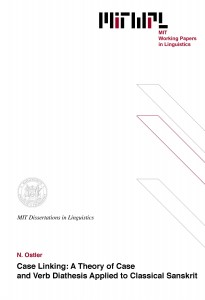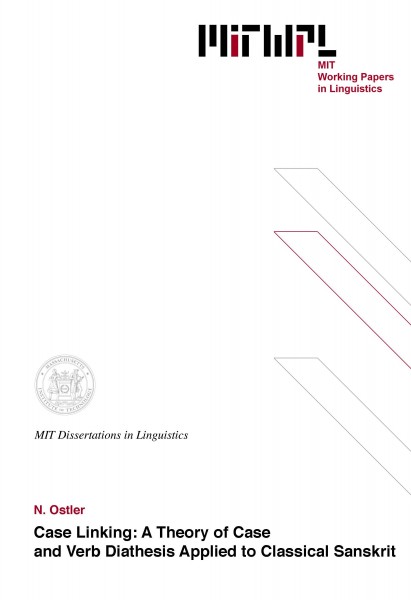Case Linking: A Theory of Case and Verb Diathesis Applied to Classical Sanskrit
N. Ostler, 1979
In this work a proposal is made for the integration of Case into syntactic and semantic theory. Case is the previous of three components of the grammar, each of which has its own internal structure. These are: the domain of Case Incidence, whose rules govern the occurrence of relevant morphological categories, in particular the Formal Cases, on the basis of syntactic information; the domain of Functional Structure, which is the framework relating Participant Roles (similar to Fillmore"s "Deep Cases") to types of predicate; and the domain of Linking itself, which establishes systematic correspondences between the morphological categories and the participant roles.
In Chapter 1, these three components are laid out. The rules of Case Incidence are a part of the syntax. They interact particularly closely with Phrase Structure, but evidence is presented (from Japanese) which suggests that the power of these rules goes beyond that of context-free PS rules. Previous attempts to formulate partial theories of functional structure are reviewed, and a new and more comprehensive attempt is made, which is localist in orientation: the concepts of Source, Goal, Theme and Path play key roles. A system of binary features is introduced, which is intended to map out the whole domain, and to provide intrinsic connexions between types of predicate and types of participant role. Linking principles are shown to be of two kinds, Semantic and Grammatical. Semantic linking rules make use of the feature system to establish intrinsic connexions between particular formal cases and particular classes of roles. Grammatical linking rules presuppose total orderings of the roles and cases respectively, and establish links on the basis of priority determined by these orderings. Extensive illustrations of these various principles are given, from Japanese and other languages. And the whole system is integrated with Bresnan"s "Realistic Transformational Grammar". The place of the Lexicon in the application of all these components is crucial, and it is suggested that lexical rules provide a neat formulation for the complex phenomena of Verb Diathesis which interact with Case.
In the remaining four chapters of the work, the system is applied to the analysis of Classical Sanskrit. A substantially complete analysis of Sanskrit phrase-structure and case-incidence is given. All the traditional cases are given respresentations in the framework which are illustrated in extenso. In Chapter 4, alternations in transitivity are investigated from the standpoint of a theory of Sanskrit lexical entries. And in Chapter 5, the Sanskrit Passive is discussed. Besides giving an analysis of it as a Diathesis within the terms of the system, the chapter also shows it to present evidence against other current theories of the passive, those due to Relational Grammar and the Revisited Extended Standard Theory.
Thesis supervisor: Rene Paul Viktor Kiparsky
Title: Professor of Linguistics
Table of Contents
Chapter I The general framework of case linking 12
1.1 Introduction 12
1.2 Structurally induced case 19
1.2.1 Introduction 19
1.2.2 The adnominal genitive and the power of structural case
marking 22
1.2.3 Japanese case arrays and the structural context of
particular cases 31
1.2.4 Formal case & morphology 38
1.3 Functional structure 41
1.3.1 Introduction 41
1.3.2 Previous approaches 43
1.3.2.1 Logic and philosophy 43
1.3.2.2 Fillmore"s "case grammar" 45
1.3.2.3 Halliday"s "transitivity systems" 47
1.3.2.4 Wallace Chafe 51
1.3.2.5 Anderson"s "Localist Case Grammar" 56
1.3.2.6 Theories based on embedding: Carter, Jackendoff 59
1.3.3 Position and identificational predicates 61
1.3.4 Themes, goals, sources and paths 65
1.3.5 Possessional and cognitional predicates inversion 75
1.3.6 Actional predicates 83
1.3.7 Embedding, external roles 91
1.3.8 Formation rules for functional structure, binding 96
1.3.9 Conclusion 99
1.4 Linking rules 101
1.4.1 Introductory overview 101
1.4.1.1 A sketch of Case linking, its relation to Bresnan"s
"Realistic Transformation Grammar" 101
1.4.1.2 Comparison with "Lexicase" 111
1.4.1.3 Comparison with generative semantics: relational
grammar; Panini"s Karaka system 114
1.4.1.4 Comparison with Chomsky"s "Revised Extended
Standard Theory" 117
1.4.2 Semantic and grammatical linking 120
1.4.3 Role features and the characterization of formal cases, case
syncretism 123
1.4.4 Semantic linking I: minimal feature specification or
prototype role? 126
1.4.5 Semantic linking II: case studies 129
1.4.5.1 Introduction 129
1.4.5.2 Japanese 130
1.4.5.3 Turkish 135
1.4.5.4 Conclusion 140
1.4.6 Grammatical linking I 141
1.4.6.1 Hierarchies of role and case 141
1.4.6.2 The subject and ergativity 146
1.4.7 Grammatical linking II: illustration from Japanese 150
1.4.8 Cater"s "Backwards Linking" vs. Inverse predicates 160
1.4.9 Substantive relations between linking and formal case
& morphology 164
1.5 Lexical entries and lexical rules 167
1.5.1 The descriptive power of lexical entries 167
1.5.2 Some restrictions 174
1.5.3 Diathesis through lexical rules 176
Chapter II Rules of form in Sanskrit 178
2.0 Introduction to the analysis of Sanskrit; tests; abbreviations 178
2.1 Categories 182
2.2 The major PS rules 187
2.2.1 PS1 188
2.2.2 PS2: impersonals in Sanskrit; finite verb morphology 190
2.2.3 PS3 196
2.2.4 PS4 199
2.3 The expansion of P" 200
2.3.1 Oblique case marking 200
2.3.2 Adverbs 201
2.3.3 Adpositions 204
2.3.4 Predicate N 208
2.3.5 Attributive and predicative position 209
2.4 Deverbal expressions 213
2.4.1 General 213
2.4.2 Deverbal nominals 215
2.4.3 Infinitives and gerunds 219
2.5 Two minor PS rules; the vocative 223
2.6 Structurally determined case 226
2.6.1 CR1 incidence of nominative under S 227
2.6.2 CR2 incidence of Acc. under V 228
2.6.3 CR3 incidence of Gen. under N 230
2.7 Case-marking rules; the concept of head 233
2.8 word order 237
Chapter III Case linking 240
3.1 Semantic linking 240
3.1.1 Introductory 240
3.1.2 Accusative 242
3.1.3 Instrumental 246
3.1.4 Dative 252
3.1.5 Ablative 255
3.1.6 Locative 259
3.1.7 Genitive 262
3.1.8 Theoretical implications 265
3.2 Grammatical linking 270
3.2.1 Introductory 270
3.2.2 Examples 275
3.2.2.1 Position 275
3.2.2.2 Possession 279
3.2.2.3 Cognition 281
3.2.2.4 Events and actions 282
3.2.3 Vivaksa: paths as subjects 285
3.2.4 Grammatical linking of the instrumental 294
3.2.5 Inverse predicates in sentient fields 300
3.3 Nominals and predication 308
3.3.1 Linking the genitive 308
3.3.2 Predication 314
3.3.3 Agreement as a phenomenon of semantic matching 320
3.3.4 A derivation 324
Chapter IV Lexical entries in Sanskrit 329
4.1 General remarks 329
4.2 Inherent and non-inherent arguments 333
4.3 "Ditransitives" 337
4.4 Transitivity 342
4.4.1 Variable transitivity and compounding 343
4.4.2 Accusative of extene, duration and content;
transitivization 351
Chapter V The passive 365
5.1 Impressionistic description 365
5.2 Relational grammar and the passive 370
5.3 A basic transformational analysis of the passive 387
5.4 A "move NP" analysis of the Sanskrit passive 397
5.5 Lexical analysis of the passive 403
5.5.1 The passive label 403
5.5.2 The personal passive 405
5.5.3 Passives of intransitive verbs 409
5.5.4 The reflexive and impersonal reflexive passives 415
5.5.5 The "1AEX" 420
5.6 A transformational-lexical solution 422

